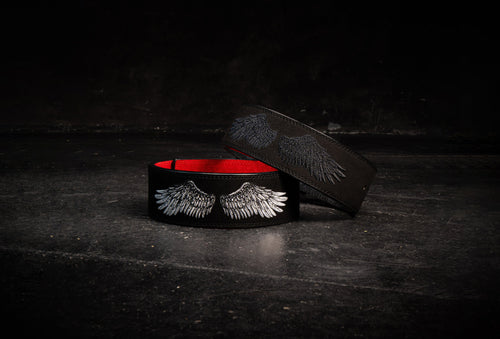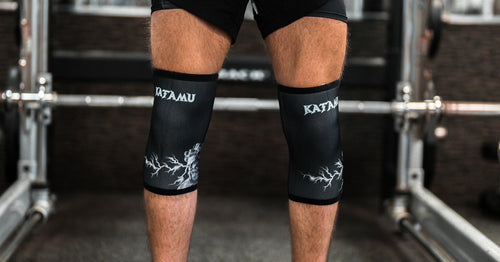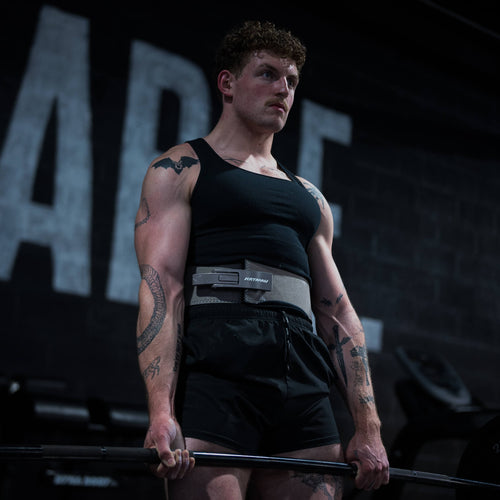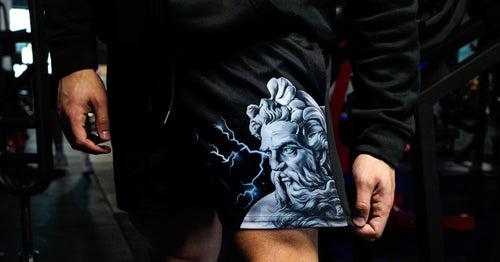Imagine stepping into the gym with a custom weight lifting belt that is tailored just for you. This guide will show you why a custom weight lifting belt is the ultimate upgrade for your training in 2025. You will discover the latest trends, how to design your own belt, what features matter most, and which brands stand out. Ready to unlock your best lifts and turn heads? Let’s dive in and find your perfect fit.
Why Choose a Custom Weight Lifting Belt?
Unlocking your potential in the gym often comes down to the gear you choose. The right custom weight lifting belt can transform not just your performance but your entire lifting experience. Let’s explore why more athletes and everyday gymgoers are choosing custom options in 2025.
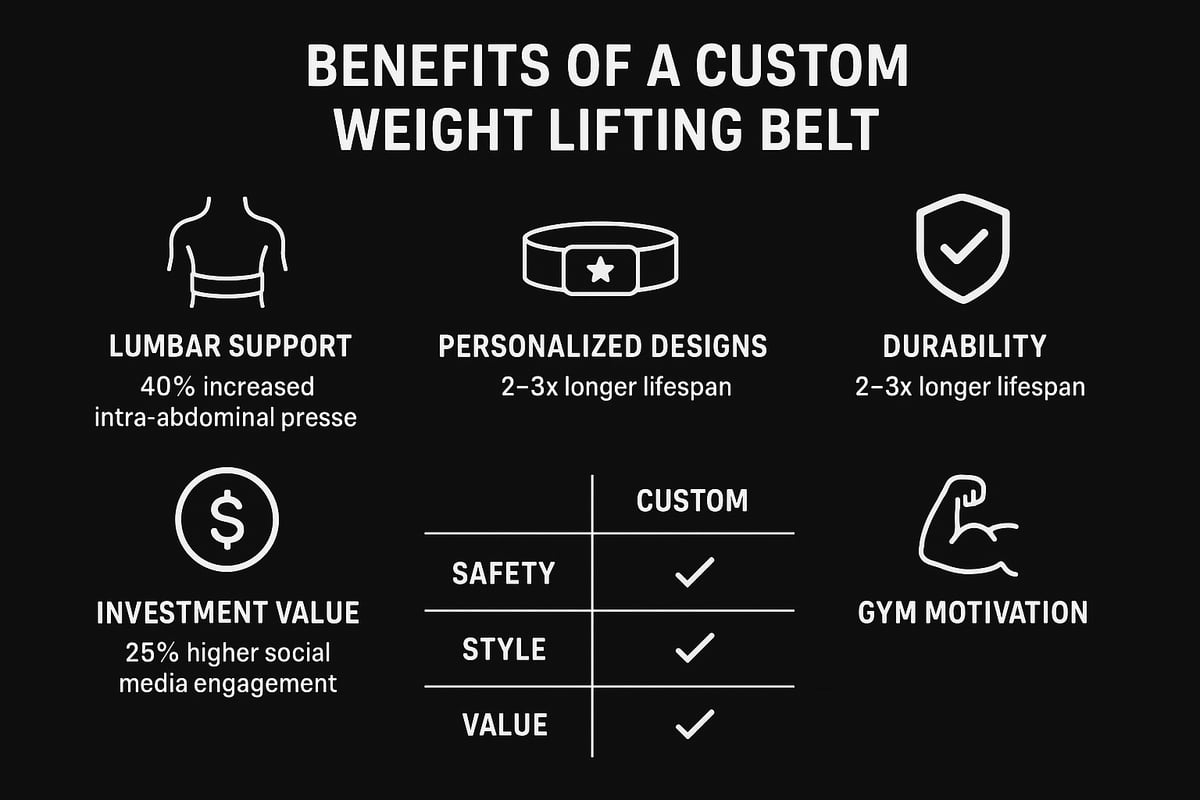
Enhanced Performance and Safety
A custom weight lifting belt is designed to fit your body, providing targeted lumbar support and stability. This tailored fit helps reduce the risk of injury during heavy lifts. In fact, studies show that proper belt use can boost intra-abdominal pressure by up to 40%, which plays a vital role in spine protection.
Unlike generic belts, custom options prevent slippage and discomfort, letting you focus on your lift. For a deeper look at the science and benefits, check out this Deep dive into lifting belts.
Personalization and Motivation
Nothing beats the feeling of strapping on a custom weight lifting belt with your name, favorite color, or team logo. Personalized belts can boost your confidence and drive, making every session feel more meaningful.
Many powerlifters and fitness enthusiasts report higher motivation levels when training with a belt that feels uniquely theirs. Customization turns a simple accessory into a source of pride and inspiration.
Durability and Material Quality
When it comes to longevity, a custom weight lifting belt stands out. Crafted from premium materials like full-grain leather and featuring reinforced stitching, these belts are built to last.
On average, a custom belt will outlast a generic one by two to three times, saving you the hassle and cost of frequent replacements. Attention to detail in construction ensures your investment supports you through countless workouts.
Stand Out in the Gym
A custom weight lifting belt is more than just functional—it’s a statement piece. Unique designs and vibrant colors help you stand out, turning heads and sparking conversations.
Social media trends show that posts featuring custom gym gear receive about 25% more engagement. Whether you compete or lift recreationally, a personalized belt helps you express your style and personality.
Investment Value
While a custom weight lifting belt may cost more upfront, it offers excellent value over time. The cost-per-use drops significantly as your belt withstands years of tough training.
Most custom belts come with solid warranties and repair options, giving you peace of mind. This long-term durability means you spend less on replacements and repairs, making it a smart financial choice for dedicated lifters.
Addressing Common Concerns
Some believe that a custom weight lifting belt is only for professionals. That’s simply not true. Modern custom belts are accessible to everyone, from beginners to seasoned athletes.
With a range of sizes, materials, and price points, there’s a custom belt for every need and budget. Don’t let myths hold you back—customization is about comfort, safety, and motivation for all.
Key Features to Consider When Designing Your Custom Belt
Designing the perfect custom weight lifting belt means balancing support, comfort, and style. Each feature you choose impacts your lifting experience, durability, and individuality. Let’s break down what really matters when you create your own belt.
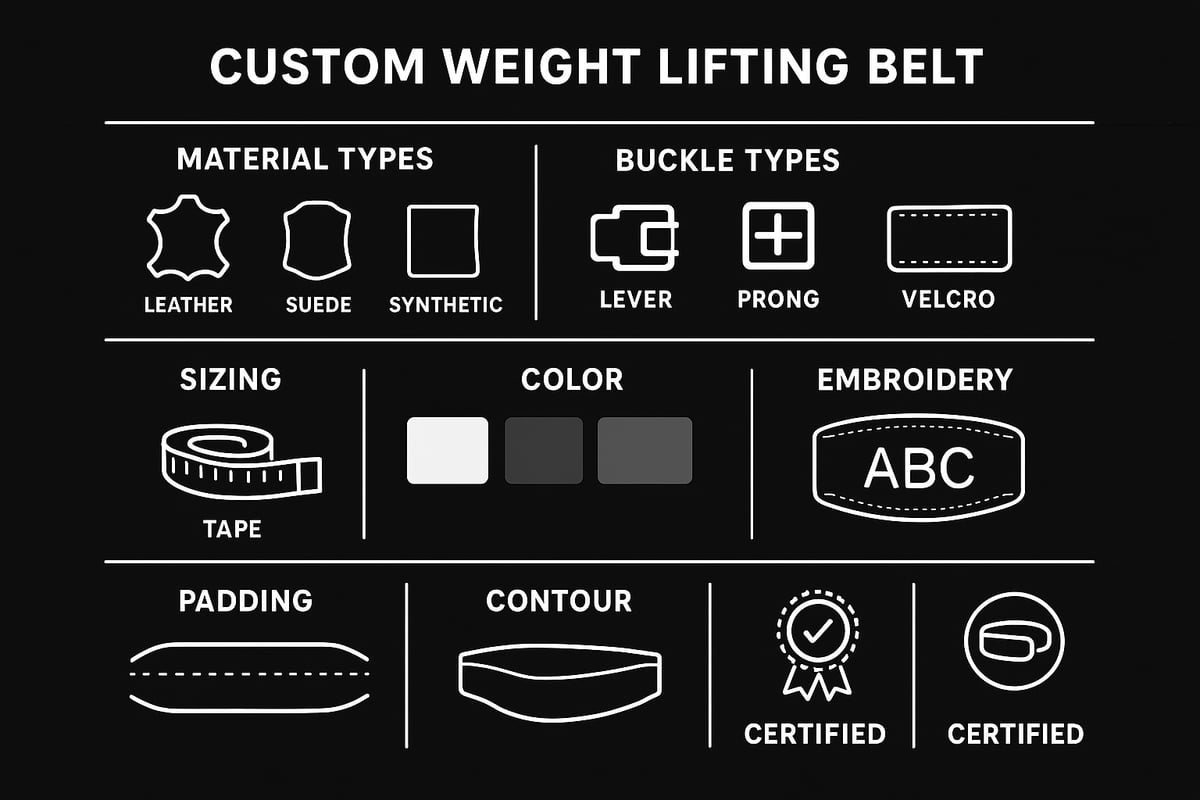
Material Selection
The material of your custom weight lifting belt sets the foundation for support and longevity. Leather is the gold standard, offering maximum durability and support for heavy lifts. Suede belts provide a softer feel and extra comfort, often preferred for longer sessions. Synthetic options are lightweight and often more affordable, but may not last as long as leather or suede.
Thickness matters too. A 10mm belt is flexible and suits most lifters, while a 13mm belt offers extra stiffness for powerlifters seeking maximum core support. Here’s a quick comparison:
| Material | Support | Comfort | Durability |
|---|---|---|---|
| Leather | High | Medium | High |
| Suede | Medium | High | Medium |
| Synthetic | Medium | High | Medium |
No matter your choice, ensure your custom weight lifting belt matches your lifting style and goals.
Buckle Types: Lever vs. Prong vs. Velcro
Choosing the right closure is crucial for your custom weight lifting belt. Lever buckles are popular among powerlifters for their quick adjustments and secure fit. Single and double-prong buckles offer classic reliability and are easy to adjust for different waist sizes. Velcro belts provide convenience and fast adjustments, ideal for lighter training or CrossFit.
Consider your training style. If you need to remove or tighten your belt between sets, a lever buckle saves time. For versatile sizing, prong buckles are a solid choice. Velcro works best for dynamic workouts, but may wear out faster with heavy use.
Sizing and Fit
A well-fitting custom weight lifting belt is essential for safety and performance. Start by measuring your waist at the navel, not your pant size. Use a flexible tape measure and check the manufacturer’s sizing chart for guidance.
Many custom belts offer extra holes or adjustable features, so you can adapt as your body changes. A snug fit ensures the belt stays in place during heavy lifts, preventing slippage and maximizing support. Always try on your belt with your typical gym clothing to guarantee accuracy.
Customization Options
Personalizing your custom weight lifting belt goes beyond just function. You can choose colors, embroidery, logos, and motivational phrases to reflect your style and keep you inspired. Popular customizations include team names, personal mottos, or unique artwork.
Some brands even allow for innovative designs like contrast stitching or metallic finishes. When selecting features, think about what will motivate you every time you step into the gym. Your custom weight lifting belt should be as unique as your journey.
Stitching and Construction Quality
The build of your custom weight lifting belt determines its durability and safety. Double stitching and reinforced edges help prevent fraying and extend the belt’s lifespan. Look for belts with high-quality thread and precise construction.
If you want a deeper dive into what separates a quality belt from the rest, this guide on best lift belt features breaks down what to watch for when evaluating craftsmanship.
A solidly built custom weight lifting belt protects you through years of heavy use.
Comfort and Break-In Period
Comfort is key, especially if you wear your custom weight lifting belt often. Padding, contouring, and material choice all play a role. Leather belts may feel stiff initially but mold to your body after a break-in period, usually a few weeks. Suede and synthetic belts tend to be softer from the start.
Expect some initial tightness, but a good belt should become more comfortable over time. If your belt pinches or restricts movement, consider adjusting the size or trying a different material.
Certification and Competition Approval
If you plan to compete, your custom weight lifting belt must meet federation requirements like IPF or USAPL standards. These organizations specify belt width, thickness, and allowable features. Always check the latest rules before finalizing your design to ensure your belt is competition legal.
A compliant custom weight lifting belt ensures you can focus on lifting, not on last-minute equipment changes.
Step-by-Step Guide: How to Order and Customize Your Weight Lifting Belt
Ordering a custom weight lifting belt is a rewarding process. With the right approach, you get a belt tailored to your training style, body, and personality. Follow these eight essential steps to ensure your belt delivers the fit, function, and flair you want.
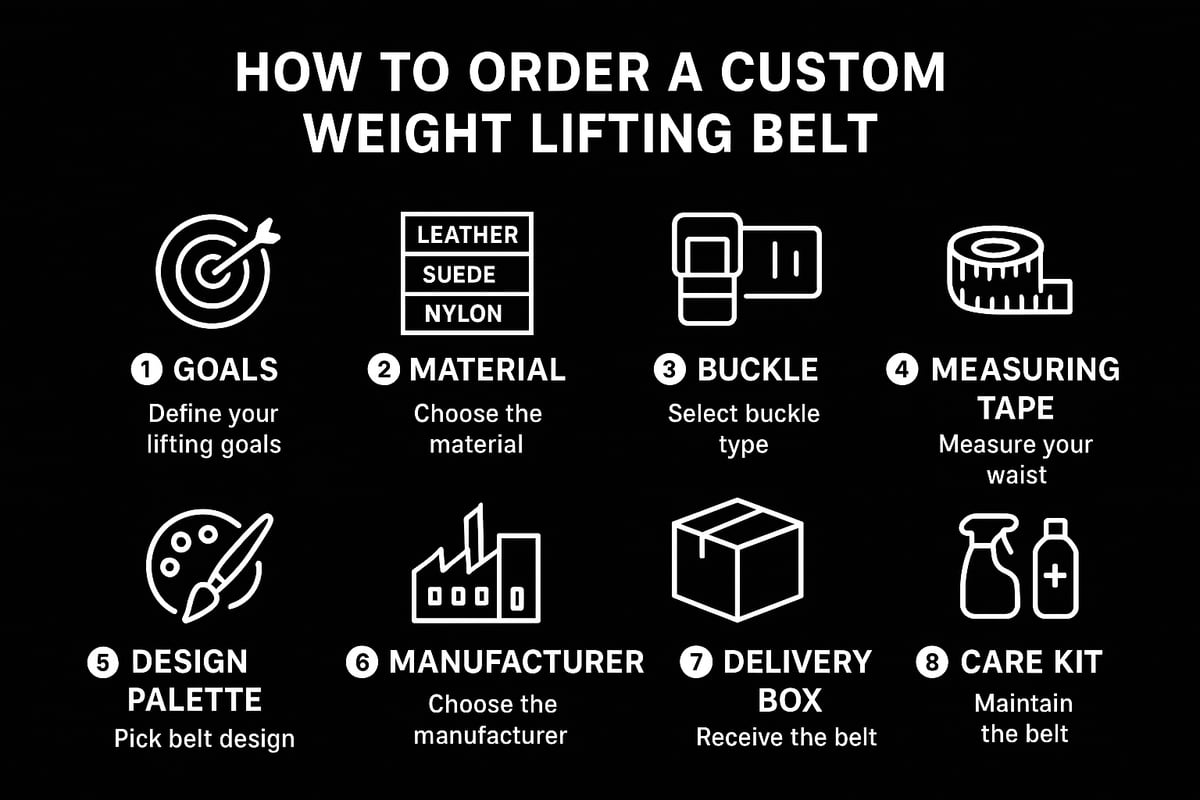
Step 1: Define Your Lifting Goals and Needs
Start by identifying your training objectives. Are you a competitive powerlifter, a CrossFit athlete, or someone focused on general strength? Each goal affects the ideal custom weight lifting belt for you.
Powerlifters often need maximum stiffness and support. Bodybuilders might prioritize comfort and flexibility. If you train for general fitness, a balanced blend of support and comfort is key.
Ask yourself:
- What lifts will I use the belt for most?
- Do I need competition approval?
- How often will I wear the belt?
By clarifying your needs up front, you set the foundation for a custom weight lifting belt that performs in every session.
Step 2: Choose the Right Material and Thickness
Material choice is crucial for the feel and performance of your custom weight lifting belt. Leather is the gold standard for support and longevity, while suede offers a softer touch. Synthetics provide a lightweight, vegan-friendly option.
Thickness matters too. Most lifters opt for 10mm belts, which balance stiffness and comfort. If you crave extra support, 13mm might be ideal. Here’s a quick comparison:
| Material | Support | Comfort | Durability |
|---|---|---|---|
| Leather | High | Medium | High |
| Suede | Medium | High | Medium |
| Synthetic | Medium | High | Medium |
Consider your training load and personal preference when selecting material and thickness for your custom weight lifting belt.
Step 3: Select Buckle Type and Hardware
The closure system is more than a style choice, it impacts safety and convenience. The main buckle types are lever, single-prong, double-prong, and Velcro.
- Lever: Fast, secure, popular for heavy lifts.
- Single-prong: Simple, adjustable, widely used.
- Double-prong: Extra security, slightly harder to adjust.
- Velcro: Lightweight, best for functional training.
Think about your lifting style and how quickly you need to adjust your custom weight lifting belt during workouts. Hardware durability is also vital, so look for solid steel or premium alloys.
Step 4: Measure for the Perfect Fit
Accurate sizing ensures your custom weight lifting belt provides optimal support. Here’s how to measure:
- Use a flexible tape measure.
- Measure around your core at the navel, not your pant line.
- Take the measurement while standing relaxed, not flexed.
- Wear typical gym clothing for accuracy.
Most brands provide sizing charts. Double-check your measurement and consider adjustable options if you expect weight changes. A well-fitted custom weight lifting belt won’t slip or dig in, even during heavy sets.
Step 5: Personalize Your Design
This is where your custom weight lifting belt becomes truly unique. Choose from a palette of colors, stitching styles, and materials. Many brands let you add:
- Embroidered names or initials
- Motivational phrases
- Team logos or icons
- Contrasting thread or edge colors
Think about what will inspire you every time you train. Innovative brands even offer artwork uploads for one-of-a-kind designs. Your custom weight lifting belt should reflect your personality and fuel your motivation.
Step 6: Place Your Order with a Reputable Manufacturer
Now it’s time to choose who will craft your belt. Research brands for quality, customer service, and customization range. Use this checklist:
- Read customer reviews and testimonials
- Check warranty and return policies
- Review customization galleries
- Compare prices and delivery times
For a comprehensive overview, see this Good lifting belts comparison to help you evaluate top-rated providers before you order your custom weight lifting belt.
Step 7: Track Your Order and Prepare for Delivery
After placing your order, you’ll receive an estimated production and shipping timeline. In 2025, most custom weight lifting belt orders take between 2 and 6 weeks from design approval to delivery.
Keep communication open with the manufacturer for updates. When your belt arrives, inspect it for quality, fit, and any custom features you requested. Having all your gear ready ensures you can start training with your new custom weight lifting belt right away.
Step 8: Break In and Care for Your New Belt
A new custom weight lifting belt can feel stiff at first. Break it in gradually by wearing it during warm-ups and lighter sets. Over time, the material will mold to your body shape.
For care, wipe the belt down after each session and store it flat in a cool, dry place. Avoid overexposure to sweat or moisture. With proper care, your custom weight lifting belt will deliver years of reliable support and keep looking sharp.
Top Custom Weight Lifting Belt Brands and What Sets Them Apart
Choosing the right custom weight lifting belt brand can make all the difference in your training journey. With so many options on the market in 2025, it helps to know what sets the top brands apart. Whether you’re looking for unmatched support, bold designs, or long-term value, the best brands deliver on every front.
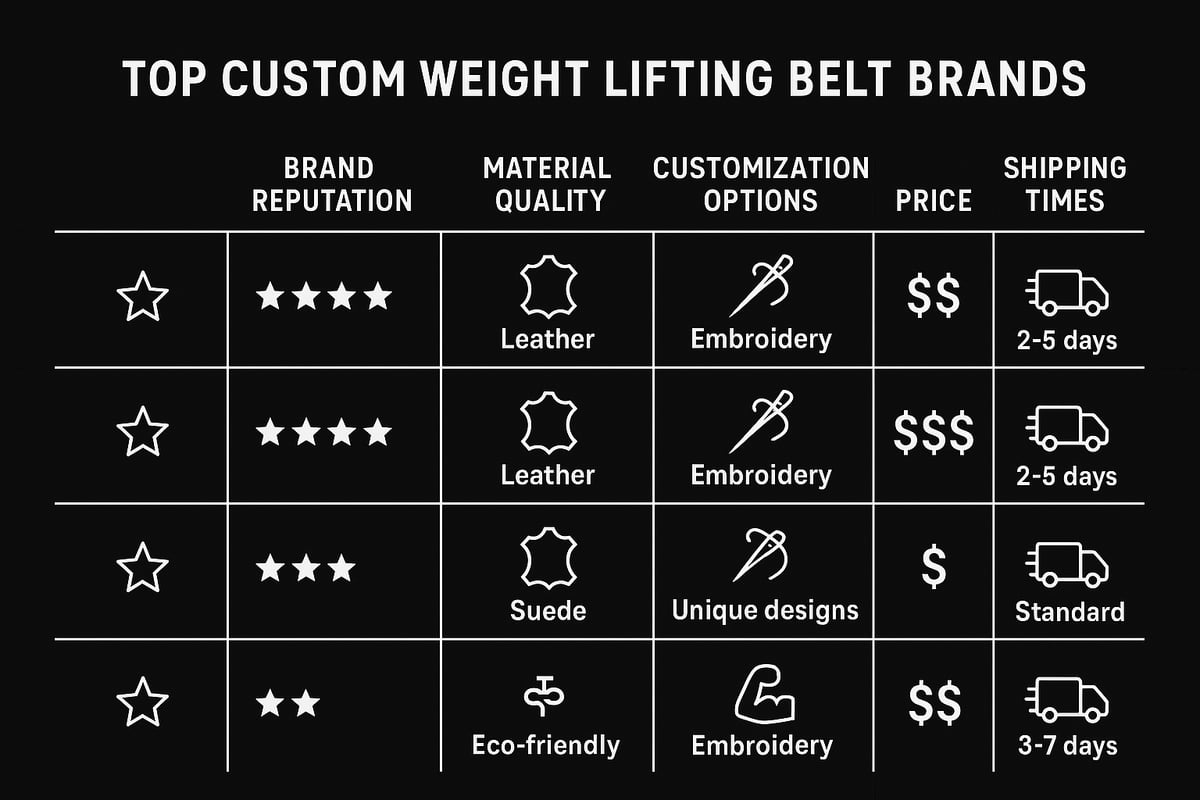
Reputation and Customer Reviews
When it comes to a custom weight lifting belt, reputation matters. The best brands consistently earn high ratings and glowing testimonials. Lifters value real-world feedback, so checking user reviews can reveal details about comfort, durability, and customer service.
Brands featured in the weightlifting belt best picks consistently score above 4.8 stars, with many users noting how these belts enhance both safety and performance. Reading through verified customer experiences can help you spot brands that truly deliver on their promises.
Material and Craftsmanship Quality
The backbone of a great custom weight lifting belt is superior material and skilled craftsmanship. Leading brands use full-grain leather, suede, or advanced synthetics, ensuring the belt stands up to heavy use.
Look for belts with reinforced stitching and robust hardware, as these features greatly impact both longevity and safety. Some brands even source eco-friendly materials, aligning with emerging sustainability trends without sacrificing performance.
Range of Customization Options
Customization is where your belt can become a personal statement. Top brands offer a wide spectrum of options, from vibrant colors to embroidered logos and motivational phrases. Innovative brands now let you upload artwork or choose from exclusive design templates.
According to weightlifting belt trends 2025: Custom, Smart & Eco-Friendly, brands that provide extensive customization options are seeing a surge in popularity. This flexibility allows lifters to create a custom weight lifting belt that reflects their style and boosts confidence on the platform.
Price Points and Value
A custom weight lifting belt is an investment, but the best brands deliver excellent cost-per-use. Expect to pay between $100 and $250 for a high-quality custom belt. What justifies the price? Premium materials, extensive design choices, and value-added perks like free accessories or lifetime warranties.
Many brands also offer bundle discounts or seasonal promotions, letting you maximize value while getting a belt built to last.
Production and Shipping Times
In 2025, production and shipping times for custom weight lifting belt orders typically range from two to six weeks. Brands known for fast turnaround and reliable delivery stand out, especially if you’re prepping for a competition or eager to upgrade your gear.
Top brands keep you informed with order tracking and responsive customer support throughout the process, making the wait as smooth as possible.
Expert Tips for Maximizing Your Custom Belt’s Performance and Lifespan
Unlocking the full potential of your custom weight lifting belt takes more than just putting it on. By following these expert strategies, you can boost both your performance and your belt's durability. Let’s dive into actionable tips that help every lifter, from beginner to advanced, get the most out of their custom gear.
Proper Wearing Technique
Getting the most out of your custom weight lifting belt starts with correct positioning. Place the belt around your waist, above your hips, and ensure it sits evenly across your lower back and abdomen. The fit should feel snug but not restrictive, allowing you to brace your core effectively.
Common mistakes to avoid include:
- Wearing the belt too high or too low
- Overtightening, which restricts breathing
- Placing the belt over bulky clothing
For lever belts, double-check the closure before each set. For a detailed breakdown of lever belt setup and technique, check out this Lever belt weightlifting guide. Mastering the fit ensures your custom weight lifting belt delivers the support you need, every time you lift.
When and How to Use Your Belt
Timing is everything with a custom weight lifting belt. The belt is most effective during heavy compound lifts, like squats and deadlifts, where core stability is crucial. Experts recommend using your belt for sets at or above 80% of your one-rep max, allowing your core to develop naturally on lighter sets.
Overusing a belt can hinder core strength, so use it strategically. A recent study on deadlift kinematics shows that belts can improve completion time and reduce exertion during heavy lifts. Remember, your custom weight lifting belt is a tool for peak performance, not a crutch for every exercise.
Maintenance and Cleaning
Proper care keeps your custom weight lifting belt in top shape for years. Follow these steps for routine maintenance:
- Wipe down the belt with a damp cloth after each session.
- Use a gentle leather or suede cleaner monthly.
- Air dry the belt away from direct sunlight.
- Store flat or hang to maintain shape.
Avoid soaking your belt in water or using harsh chemicals. Regular cleaning prevents odor and mildew, ensuring your custom weight lifting belt remains comfortable and hygienic.
| Material | Cleaning Frequency | Special Notes |
|---|---|---|
| Leather | Monthly | Use leather balm |
| Suede | Bi-weekly | Brush gently |
| Synthetic | Bi-weekly | Mild soap only |
Monitoring Wear and Tear
Inspect your custom weight lifting belt routinely for signs of damage. Look for frayed stitching, cracks in the leather, or loose hardware. If you notice any of the following, it may be time for repair or replacement:
- Belt no longer closes securely
- Warped or stretched material
- Unusual squeaking or stiffness
Rotating between two belts can extend their lifespan. Regular checkups keep your custom weight lifting belt safe and effective.
Adjusting Fit Over Time
Your body changes, and your custom weight lifting belt should adapt with you. If you gain or lose weight, use adjustable hardware or add extra holes for a secure fit. Always re-measure your waist if you notice the belt feels loose or overly tight.
Some belts offer interchangeable buckles or straps for added flexibility. Ensuring a tailored fit maintains the comfort and performance you expect from a custom weight lifting belt.
Incorporating Your Belt into Training Programs
Balance is key when integrating your custom weight lifting belt into your workouts. Coaches suggest reserving belt use for maximal or near-maximal lifts, while training beltless for accessory movements. This approach builds core strength and prevents dependency.
Try periodizing your belt use:
- Use the belt during peak intensity weeks
- Train without the belt during lighter phases
This strategy helps you progress safely and efficiently, making the most of your custom weight lifting belt.
Community and Motivation
Sharing your custom weight lifting belt journey can keep you motivated. Post progress photos, belt designs, or personal records on social media. Engaging with lifting communities offers support, tips, and inspiration.
Many lifters find that showcasing their custom weight lifting belt online builds accountability and pride. Join forums or follow hashtags to connect with others and stay motivated through every rep.
Now that you’ve got the full scoop on custom weight lifting belts and what really makes a difference in quality, comfort, and style, it’s the perfect time to think about your own setup. Whether you’re chasing new PRs or just want a belt that fits your vibe and lasts for years, having the right gear can seriously boost your confidence and performance in the gym. Ready to take the next step and put all this knowledge into action?
Build your setup
